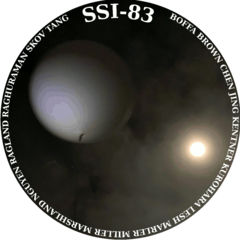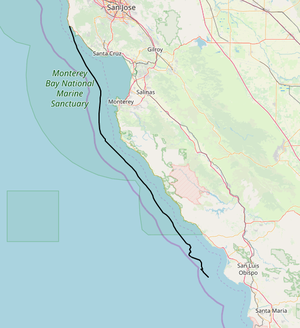SSI-83
| SSI-83 | ||||
|---|---|---|---|---|

| ||||
| Designations | CY-1 | |||
| Launch date | April 17, 2019, 22:30 PDT | |||
| Launch site | Pigeon Point Light Station, Pescadero, CA | |||
| Launch coordinates | 37.1827, -122.3923 | |||
| Flight duration | 60h:33m | |||
| Flight length | 267 km | |||
| Flight profile | Marine tether | |||
| Last contact | April 20, 2019, 11:03 PDT | |||
| Last location | 13.7 km WSW of Point Buchon, San Luis Obispo County, CA | |||
| Last coordinates | 35.2168, -121.0458 | |||
| ||||
SSI-83 (project designation CY-1) was the maiden launch of Project Cycloon on April 17, 2019. A proof-of-concept of Cycloon's aero-marine platform architecture, it was the first marine-tether profile launch in SSI's history. It was also a rare nighttime launch, a rare weekday launch, and the first-ever launch from Pigeon Point Light Station.
Project context
Discussions of Cycloon's maiden launch had been underway since shortly after the project's inception in January 2019. It was initially envisioned that the HF transceiver system would be first tested via a ground-tethered balloon in February 2019, followed by a demonstration of the marine tether in March. However, as progress on the HF transceiver stalled, partly due to supply-chain delays, it was decided to move forward with the marine tether launch.
The flight profile for the marine tether launch was initially envisioned to involve a slow daytime ascent and nighttime descent into the Pacific ocean under passive altitude control. This would have offered significant technical challenges in terms of precision filling and weighing. Nevertheless, this flight profile offered appealing advantages in terms of flight endurance; several simulated profiles in February traveled due west into the Pacific, offering a nearly indefinite potential mission duration. In order to demonstrate the long-term viability offered by the marine tether concept, such endurance was considered a high priority.
By March, it became increasingly clear that such a rise-fall-float profile would be increasingly unlikely due to seasonal wind patterns. While the development of Apex Vent, another Cycloon project, would have opened up numerous more windows, it was decided that it would be infeasible to delay the maiden launch until after its development. Thanks to the technical simplicity of a float-only profile, such a profile became the target of launch window searches.
The early evening of April 7, 2019 was identified as such a launch window on March 31, from which trajectories either went into the open Pacific or into Baja California depending on the floating coefficient. Due to the short notice, systems design, construction, and testing occurred at a rapid pace in the ensuing week. As the date approached, however, simulations no longer showed favorable surface winds along the coast, and the launch was cancelled the evening of April 5. In post-analysis, it was noted that alternate launch sites including Point Reyes and Big Sur would have sufficed, thus prompting an awareness of running launch window searches from multiple sites.
The launch window of April 17, 2019 was identified on April 9. While the likelihood of making landfall in Baja California was high, it was decided that a multi-day mission to Baja California would already be sufficient success. Furthermore, the possibility remained of waiting out for more favorable winds in Baja California. Thanks to the progress made in preparation for the cancelled launch, system assembly was rapid and concluded on April 14. Simulations began showing an increasing likelihood of making landfall in southern California instead of Baja, so system design was optimized to avoid this outcome. In the final mission configuration and profile, the chief aims were to demonstrate the marine tether as a proof of concept and gather data on system drag, the floating coefficient, and the tether angle.
Configuration
Balloon: Kaymont 1500g latex.
Payload: Solid plastic permeable enclosure and two inner waterproofing layers. The aim of this configuration was to increase system density as much as possible, such that balloon envelope failure would lead to immediate loss of communications, while protecting the system against occasional waves. Mass: 1.73kg.
Avionics: Teensy 3.2, BMP280, BNO055, TinyGPS, and RockBlock modem on a protoboard, transmitting all data except orientation at lengthening intervals. A SPOT Trace was added at the launch site due to avionics difficulties. No RockBlock communications were received; in post-analysis, a bug was found in the code.
Power: 42 standard alkaline AA batteries. This was calculated to be sufficient for three weeks, the most optimistic conditions possible.
Tether and floater: 30m paracord tether from balloon to payload and 30m paracord tether from balloon to floater. Total tether mass: 0.42kg. Floater mass 2.0kg and volume slightly over 2.0L. Optimizations for floater mass and volume, tether length, and balloon fill were considered for the sake of greater endurance and tether angle during strong winds.
Mass budget: 5.65kg. Balloon filled to 4.91kg of total lift to yield system free lift -0.74kg, a 15% thermal buffer.
Flight synopsis
April 17 2230 PDT: Balloon released. SPOT transmissions regular.
April 18 1128 PDT: Extended STOP signal from Monterey Bay (36.28947,-122.04300). This and future STOP signals were determined to be due to calm conditions failing to trigger the SPOT accelerometer. However, at the time it was not clear if the flight had terminated. By this time, the nighttime floating coefficient had been determined to be no greater than 0.4, making a landfall in southern California almost certain.
April 18 1538 PDT: SPOT transmissions resumed from (36.14631,-121.86490) in conjunction with wind speeds exceeding 2m/s.
April 19 0449 PDT: Extended STOP signal from (35.58399,-121.35461). By this time, the daytime floating coefficient was observed to be up to 0.5. Nevertheless, due to the trajectory paralleling the coast more than expected, landfall was projected to occur in the afternoon of April 20 in San Luis Obispo county, and plans for recovery were being discussed. A plan to restore RockBlock and relaunch from the landfall site was considered.
April 19 0814 PDT: SPOT transmissions resumed from (35.48765,-121.26381). Trajectory had been staying southward despite increasing west winds, making landfall time and location increasingly uncertain.
April 19 1118 PDT: Erratic, slow southward motion began from (35.45337,-121.21738), in contrast to the relatively rapid, southeastward motion thus far and particularly contradicting local wind conditions. In post analysis, it was determined that the floater and tether likely became snagged on a large piece of floating debris at this time. At the time, it was uncertain if the balloon had failed and the payload were floating.
April 19 2326 PDT: After a full day of erratic motion with frequent extended STOPs, the trajectory accelerated to the southeast from (35.35143,-121.12985), consistent with surface winds.
April 20 1013 PDT: Southeastward motion continued after a STOP from (35.23742,-121.06796), partially but not fully consistent with winds, which still predicted imminent landfall.
April 20 1103 PDT: Last contact, the second of two consecutive STOP signals, from 13.7 km WSW of Point Buchon in San Luis Obispo county. A follow-up call to Point San Luis lighthouse in the afternoon yielded no observations, and the flight was deemed terminated.
| Balloon Launches | |
|---|---|
| 2014-15 | SSI-19 • 20 • 21 • 22 |
| 2015-16 | SSI-23(a) • 24 • 25 • 26 • 27 • 28 • 29 • 30 • 31 • 32 • 33 • 34 • 35 • 36 • 37 • 38 • 39 • 40 • 41 • 42 • 43 |
| 2016-17 | 44 • 45 • 46 • 47 • 48 • 49 • 50 • 51 • 52 |
| 2017-18 | |
| 2018-19 | 83 • 86 • 87 • 90 • 91 |
| 2019-20 | 92 • 93 • 97 |
| V • E | |
